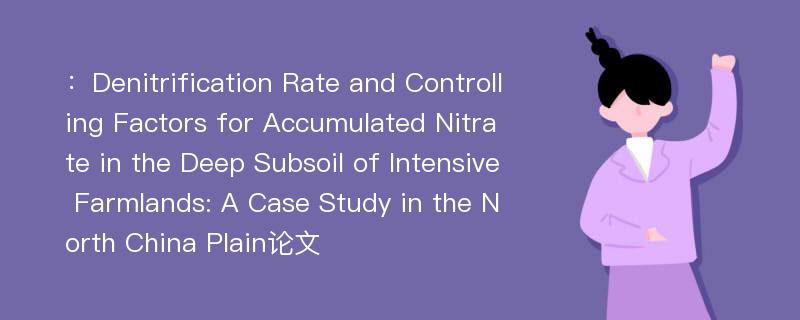
本文主要研究内容
作者(2019)在《Denitrification Rate and Controlling Factors for Accumulated Nitrate in the Deep Subsoil of Intensive Farmlands: A Case Study in the North China Plain》一文中研究指出:Denitrification in subsoil(to a depth of 12 m) is an important mechanism to reduce nitrate(NO3-) leaching into groundwater.However, regulating mechanisms of subsoil denitrification, especially those in the deep subsoil beneath the crop root zone, have not been well documented. In this study, soil columns of 0–12 m depth were collected from intensively farmed fields in the North China Plain. The fields had received long-term nitrogen(N) fertilizer inputs at 0(N0), 200(N200) and 600(N600) kg N ha-1year-1. Main soil properties related to denitrification, i.e., soil water content, NO3-, dissolved organic carbon(DOC), soil organic carbon(SOC),pH, denitrifying enzyme activity(DEA), and anaerobic denitrification rate(ADR), were determined. Statistical comparisons among the treatments were performed. The results showed that NO3- was more heavily accumulated in the entire soil profile of the N600 treatment, compared to the N0 and N200 treatments. The SOC, DOC, and ADR decreased with increasing soil depth in all treatments,whereas considerable DEA was observed throughout the subsoil. The long-term fertilizer rates affected ADR only in the upper 4 m soil layers. The ADRs in the N200 and N600 treatments were significantly correlated with DOC. Multiple regression analysis indicated that DOC rather than DEA was the key factor regulating denitrification beneath the root zone. Additional research is required to determine if carbon addition into subsoil can be a promising approach to enhance NO3- denitrification in the subsoil and consequently to mitigate groundwater NO3- contamination in the intensive farmlands.
Abstract
Denitrification in subsoil(to a depth of 12 m) is an important mechanism to reduce nitrate(NO3-) leaching into groundwater.However, regulating mechanisms of subsoil denitrification, especially those in the deep subsoil beneath the crop root zone, have not been well documented. In this study, soil columns of 0–12 m depth were collected from intensively farmed fields in the North China Plain. The fields had received long-term nitrogen(N) fertilizer inputs at 0(N0), 200(N200) and 600(N600) kg N ha-1year-1. Main soil properties related to denitrification, i.e., soil water content, NO3-, dissolved organic carbon(DOC), soil organic carbon(SOC),pH, denitrifying enzyme activity(DEA), and anaerobic denitrification rate(ADR), were determined. Statistical comparisons among the treatments were performed. The results showed that NO3- was more heavily accumulated in the entire soil profile of the N600 treatment, compared to the N0 and N200 treatments. The SOC, DOC, and ADR decreased with increasing soil depth in all treatments,whereas considerable DEA was observed throughout the subsoil. The long-term fertilizer rates affected ADR only in the upper 4 m soil layers. The ADRs in the N200 and N600 treatments were significantly correlated with DOC. Multiple regression analysis indicated that DOC rather than DEA was the key factor regulating denitrification beneath the root zone. Additional research is required to determine if carbon addition into subsoil can be a promising approach to enhance NO3- denitrification in the subsoil and consequently to mitigate groundwater NO3- contamination in the intensive farmlands.
论文参考文献
论文详细介绍
论文作者分别是来自Pedosphere的,发表于刊物Pedosphere2019年04期论文,是一篇关于,Pedosphere2019年04期论文的文章。本文可供学术参考使用,各位学者可以免费参考阅读下载,文章观点不代表本站观点,资料来自Pedosphere2019年04期论文网站,若本站收录的文献无意侵犯了您的著作版权,请联系我们删除。
